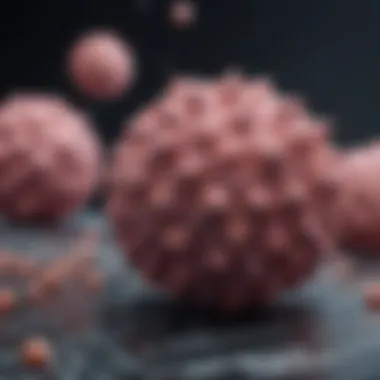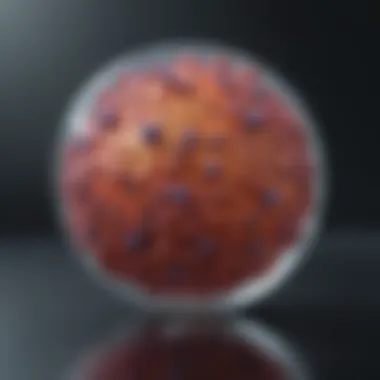Exploring Mirati Kras G12C Inhibitors in Cancer Therapy


Intro
The advent of targeted therapies in oncology has shed new light on the treatment avenues available for various malignancies. One such important breakthrough is the development of Mirati Kras G12C inhibitors. These drugs specifically target mutations in the KRAS gene, particularly the G12C variant, which is implicated in numerous cancers. The increasing focus on precision medicine underscores the significance of understanding these inhibitors, their mechanisms, and clinical applications.
Mirati Therapeutics has been at the forefront of introducing these G12C inhibitors, and they signify a paradigm shift in the approach toward oncogene-driven tumors, moving beyond conventional chemotherapies. This article will provide an in-depth exploration of the role these inhibitors play in cancer treatment, from their basic biological mechanisms to current research outcomes.
Research Overview
Summary of Key Findings
Research into Mirati Kras G12C inhibitors has uncovered several key findings. For instance, they have shown promising efficacy in treating advanced malignancies driven by KRAS G12C mutations. Clinical trials have revealed a potential for prolonged progression-free survival in patients responding to these targeted therapies. Moreover, these inhibitors appear to act synergistically with other treatment modalities, enhancing overall efficacy.
Methodologies Employed
The research methodologies utilized to assess the efficacy of Mirati Kras G12C inhibitors range from in vitro studies to large-scale clinical trials. Scientists have employed pharmacokinetic studies to evaluate the absorption and distribution of these drugs within the body. Preclinical models, particularly patient-derived xenograft models, have enabled researchers to observe drug responses in a controlled environment, providing crucial insights into dosing and effectiveness.
In-Depth Analysis
Detailed Examination of Results
The results from recent studies focusing on Mirati Kras G12C inhibitors highlight not only the efficacy of these drugs but also the importance of patient selection in clinical settings. Biomarkers indicating G12C mutations significantly inform treatment decisions, allowing for personalized therapeutic approaches. In specific trials, patients demonstrated significant tumor reduction, illustrating that targeted inhibition has observable results in real-world scenarios.
Comparison with Previous Studies
In comparison with earlier studies on broad-spectrum chemotherapy, Mirati Kras G12C inhibitors present a more tailored approach. Traditional treatments often result in systemic side effects due to their nonspecific action on cancer cells. In contrast, the targeted nature of G12C inhibitors offers a chance to minimize collateral damage to healthy tissues. Furthermore, the innovative mechanism of action has drawn substantial interest, illustrating a shift in the therapeutic landscape away from generalized strategies toward more focused interventions.
Preface to Mirati Kras G12C Inhibitors
The emergence of targeted therapies has significantly shaped cancer treatment in recent years. Among these, the Mirati Kras G12C inhibitors stand out for their potential to revolutionize the approach to specific malignancies harboring Kras mutations. Understanding the role of these inhibitors is paramount, as they mark a pivotal point in the journey towards precision medicine. This introduction will provide an overview of the importance of Kras G12C inhibitors in contemporary oncology, shedding light on key elements such as the mechanisms involved, their benefits, and the broader implications for patient care.
Historical Context of Kras Research
The Kras gene, a crucial player in cell signaling pathways, has been a subject of extensive research since its discovery. Initially identified in the mid-1980s, Kras mutations were linked to various cancers, including pancreatic, colorectal, and lung cancer. These findings paved the way for a deeper understanding of oncogenes and their role in tumorigenesis.
Historically, Kras mutations were considered "undruggable" due to the challenges in targeting the protein effectively. However, advances in molecular biology and drug discovery techniques led to the identification of specific mutations, particularly the G12C variant. This has renewed interest in targeting Kras and has driven substantial research funding and innovation.
Understanding these historical milestones is essential for grasping the significance of Mirati Kras G12C inhibitors in the current landscape of cancer therapies. Their development reflects a shift towards more precise targeting strategies that focus on specific molecular alterations, enhancing treatment efficacy while aiming to minimize systemic side effects.
What are G12C Inhibitors?
G12C inhibitors are a class of therapies specifically designed to target the G12C mutation of the Kras protein. The G12C mutation occurs from a substitution of glycine with cysteine at position 12 of the Kras protein. This alteration results in constitutive activation of Kras, driving uncontrolled cell proliferation and survival.
Mirati Therapeutics has developed inhibitors that selectively bind to the mutated form of Kras, thereby blocking its activity. The mechanism of action involves irreversible binding to the cysteine residue, which inhibits the downstream signaling pathways involved in cancer growth and progression. This specificity is crucial, as it allows for minimizing effects on normal cells, potentially reducing overall toxicity.
The introduction of Mirati G12C inhibitors represents a significant advancement in targeted cancer therapy. Their design not only provides a novel treatment option for patients with tumors harboring this specific mutation but also exemplifies the potential of precision medicine to improve outcomes in oncological care. As research continues, understanding their full capabilities and implications will be essential for clinicians and patients alike.
The Biological Basis of Kras Mutations


Understanding the biological basis of Kras mutations is essential in the context of cancer treatment. The Kras gene is a critical component in cell signaling pathways that regulate cell division and growth. When mutations occur in this gene, particularly in the G12C position, they can lead to uncontrolled cell proliferation and tumor formation. This section will explore the intricacies of Kras gene function and the specific implications of Kras mutations in cancer.
Kras Gene Function
The Kras gene encodes a protein that is part of the Ras family of proteins. This protein acts as a molecular switch that toggles between an active and inactive state. In its active form, Kras promotes signaling pathways that encourage cellular growth and division, while in its inactive state, these processes are halted. The balance of Ras activity is crucial; mutations that lock Kras into the active state can cause persistent signaling. As a result, the cell continues to grow despite regulatory signals that normally would inhibit such behavior.
Key functions of the Kras gene include:
- Cell proliferation: Stimulates the growth and division of cells, which is fundamental to tissue maintenance.
- Survival signaling: Helps cells resist programmed cell death, allowing abnormal cells to survive longer.
- Cellular differentiation: Influences how cells develop into different types that make up tissues.
Mechanism of Kras Mutations in Cancer
Kras mutations, particularly the G12C variant, lead to significant changes in cellular behavior. This specific mutation occurs when a glycine is replaced by cysteine at position 12 in the protein sequence. The altered protein behaves as if it is continuously activated, which deregulates the normal growth signaling pathways. This continuous activation results in:
- Increased growth and survival: Cancer cells are able to evade apoptosis, contributing to tumor growth.
- Enhanced metastatic potential: With persistent signaling, tumor cells can invade surrounding tissues and spread to other parts of the body.
- Resistance to traditional therapies: Tumors driven by Kras mutations often show limited responsiveness to standard chemotherapy.
"Kras mutations are found in approximately 25% of all human cancers, making them significant targets for therapeutic development."
In summary, the biological basis of Kras mutations highlights their pivotal role in cancer pathogenesis. The dysfunction of the Kras protein due to mutations like G12C is instrumental in the development and progression of various malignancies. Understanding these molecular mechanisms is crucial for developing targeted therapies, such as Mirati Kras G12C inhibitors, which aim to restore normal regulatory control over cancer cell growth.
Mechanism of Action of Mirati Kras G12C Inhibitors
The mechanism of action of Mirati Kras G12C inhibitors is a central focus of this article, as it reflects the scientific foundations that drive their application in cancer treatment. A detailed comprehension of this mechanism is crucial not only for understanding the inhibitors themselves but also for appreciating their implications on the broader field of oncology. These inhibitors are designed to selectively target tumors with the Kras G12C mutation, which is common in various forms of cancer, particularly lung adenocarcinoma and colorectal cancer.
Understanding this selectivity allows for a more precise treatment approach, potentially reducing the side effects associated with traditional chemotherapy. Through their targeted nature, these inhibitors aim to disrupt the oncogenic signaling pathways activated by the mutated Kras protein.
Targeting the G12C Mutation
Mirati Kras G12C inhibitors specifically target the G12C mutation in the Kras oncogene. This mutation causes a single amino acid substitution, resulting in constitutive activation of the Kras protein and subsequent promotion of tumor growth.
By binding directly to the mutated form of Kras G12C, these inhibitors effectively block its activity. This inhibition reduces the downstream signaling that would typically lead to cell proliferation and survival.
Importantly, the selectivity towards the G12C mutation is a significant advantage over broader, less specific treatments. For patients harboring this mutation, Mirati inhibitors offer a focused approach, potentially improving treatment efficacy.
Interaction with Intracellular Pathways
Once the Mirati Kras G12C inhibitors bind to the mutated Kras protein, they instigate a cascade of biological changes. Intracellularly, the inhibition of Kras leads to the interruption of various signaling pathways. Two major pathways are notably affected: the MAPK and PI3K/AKT pathways.
By blocking these pathways, the inhibitors reduce the transcription of genes that drive cell growth and proliferation. This blockage is critical because cancer cells often rely on these pathways for survival and continued growth.
"The ability to selectively inhibit the G12C mutation opens new frontiers in precision oncology, tailoring treatments to the genetic profiles of tumors."
The interaction with these pathways not only diminishes the proliferation of cancer cells but also induces cellular apoptosis, or programmed cell death. This dual action of inhibiting growth signals and promoting cell death is a hallmark of effective cancer therapy.
Clinical Applications of Mirati Kras G12C Inhibitors
The emergence of Mirati Kras G12C inhibitors represents a pivotal shift in cancer treatment strategies. As tumors driven by specific genetic mutations like Kras G12C become more understood, targeted therapies offer hope for improved outcomes. The clinical applications of these inhibitors are particularly significant in the realm of precision medicine.
Indications for Use


Mirati's Kras G12C inhibitors have specific indications in treating cancers associated with the G12C mutation, which occurs primarily in non-small cell lung cancer (NSCLC), colorectal cancer, and pancreatic cancer. These cancers often exhibit poor prognosis with conventional therapies. The use of Kras G12C inhibitors allows for more tailored treatment regimens based on the molecular profile of the tumor.
Current evidence supports the administration of these inhibitors in patients who have failed standard therapies, providing an essential option where few exist. The approval of drugs like Mirati Therapeutics' Adagrasib has shown promising results in clinical settings, decreasing tumor burden and enhancing survival rates among patients with mutations in their cancer cells. Adagrasib is currently prescribed for adult patients with locally advanced or metastatic NSCLC and G12C mutation.
Current Clinical Trials
As the potential of Mirati Kras G12C inhibitors unfolds, many clinical trials aim to further investigate their efficacy and safety. Ongoing trials include:
- Phase 1/2 studies assessing Adagrasib's effectiveness not only in NSCLC but also in colon cancer.
- Combination studies evaluating the effectiveness of Adagrasib with immunotherapies or chemotherapy agents, testing whether synergistic effects can improve patient outcomes further.
- Long-term follow-ups to monitor overall survival rates and quality of life for patients receiving these targeted therapies.
The goal of these trials is to establish comprehensive data on the treatment landscape and refine strategies for deploying these inhibitors effectively. Insights gained from these studies will shape clinical guidelines and potentially lead to broader approvals for use in other cancers associated with Kras mutations.
In summary, the clinical applications of Mirati Kras G12C inhibitors are a beacon of hope for many cancer patients. Their targeted approach not only aligns with advances in personalized medicine but also underscores the importance of ongoing clinical research.
Benefits of Mirati Kras G12C Inhibitors
The advent of Mirati Kras G12C inhibitors marks a significant milestone in cancer treatment. These targeted therapies are a response to the urgent need for effective treatments for cancers with specific Kras mutations, particularly the G12C variant. This section delves into the specific advantages these inhibitors offer, emphasizing their role in precision medicine and patient outcomes.
Precision Medicine Approach
Precision medicine is gaining ground in oncology, allowing for therapies tailored to the individual characteristics of each patient or their specific disease. Mirati Kras G12C inhibitors exemplify this approach by directly targeting the mutant form of the Kras protein that drives tumor growth in certain cancers.
The importance of precision medicine cannot be overstated. It not only increases the likelihood of treatment success but also minimizes unnecessary side effects for patients. The strategy of using Mirati inhibitors ensures that treatments are effective against tumors that exhibit the G12C mutation, thus sparing other patients from ineffective treatments that may cause harm without benefit.
- Increased Efficacy: Research shows that patients with G12C mutations respond more positively to these inhibitors compared to broader treatments.
- Biomarker Utilization: The ability to use genetic testing to identify G12C mutations ensures that only suitable candidates receive this specific therapy, making it a more precise treatment option.
"The shift towards precision medicine in cancer therapy is transforming outcomes and fostering a deeper understanding of the individual tumor biology."
Improved Patient Outcomes
The clinical application of Mirati Kras G12C inhibitors has resulted in better patient outcomes in several ways. Clinical trials indicate that these targeted therapies can lead to significant tumor shrinkage and prolonged survival in patients. This is particularly notable in cancers such as non-small cell lung cancer, where G12C mutations are prevalent.
- Response Rates: Studies demonstrate that many patients treated with Mirati inhibitors show a marked reduction in tumor size. This correlation highlights the potential efficacy of these drugs in combating aggressive cancers.
- Survival Benefits: Patients on these targeted therapies have experienced longer disease control, showcasing that precision targeting can extend life expectancy.
- Quality of Life: Besides extending overall survival, the specific targeting minimizes side effects associated with traditional chemotherapy and radiation, allowing patients to maintain a better quality of life throughout treatment.
As ongoing research continues to uncover the full impact of Mirati Kras G12C inhibitors, it is increasingly clear that their use embodies a paradigm shift in cancer treatment. By harnessing the unique aspects of each patient's tumor profile, these treatments represent a hopeful advance in the fight against cancer.
Challenges in Development and Implementation
The potential of Mirati Kras G12C inhibitors in cancer treatment is undeniable. However, its development and implementation face significant challenges that must be addressed.
Resistance Mechanisms
One of the primary concerns in targeted therapy is the emergence of resistance mechanisms. Cancer cells can adapt to therapies, often rendering them ineffective over time. This is seen with G12C inhibitors, where mutations in the KRAS gene or activation of alternative signaling pathways can lead to treatment failure. Understanding these resistance pathways is crucial for improving the efficacy of G12C inhibitors. Research indicates that secondary mutations in the Kras gene can occur, leading to conformational changes that prevent the inhibitor from binding effectively.
Key factors influencing resistance mechanisms include:
- Genetic Adaptations: Cancer cells can develop mutations that facilitate continued growth despite G12C inhibitor presence.
- Compensatory Pathway Activation: When one pathway is inhibited, others may be activated, helping cancer cells bypass the effects of the drug.
- Tumor Microenvironment: External factors in the tumor's surrounding environment may also promote resistance.


These resistance issues necessitate ongoing research to develop combination therapies or next-generation inhibitors that can overcome these hurdles.
Side Effects and Toxicity
Another critical challenge is managing side effects and toxicity associated with Mirati Kras G12C inhibitors. While targeted therapies generally aim for precision and less collateral damage than traditional chemotherapy, they are not free from adverse reactions. Patients undergoing treatment may experience various side effects, which can impact their quality of life and willingness to continue therapy.
Common side effects can include:
- Gastrointestinal Issues: Nausea, vomiting, and diarrhea are often reported.
- Skin Reactions: Rash or itchiness may occur as the body reacts to the drug.
- Fatigue: Many patients experience increased tiredness, which can be debilitating.
The management of these side effects is crucial. Supportive care strategies, such as symptom management and dosage adjustments, can help mitigate toxicities. Continuous monitoring during therapy allows healthcare providers to respond promptly to any adverse effects, enhancing overall treatment adherence.
Managing resistance mechanisms and side effects is vital for success in utilizing Mirati Kras G12C inhibitors in cancer therapy.
Future Directions in Kras Inhibition Research
The landscape of cancer treatment is constantly evolving, particularly in the realm of targeted therapies. This section aims to highlight the significance of future directions in Kras inhibition research. As science advances, it becomes imperative to explore novel strategies that refine the efficacy of Kras G12C inhibitors. The necessity for innovative approaches arises from the challenges faced in current therapeutic modalities. Moreover, understanding these directions not only enhances treatment outcomes but also addresses the biogenesis of drug resistance.
Emerging Combination Therapies
Combination therapies represent one of the most promising avenues for enhancing the effectiveness of Mirati Kras G12C inhibitors. When cáncer therapies target different aspects of tumor biology, they can potentially synergize, leading to improved responses. For instance, combining inhibitors with checkpoint inhibitors or chemotherapy could maximize the reduction of tumor burden.
Some emerging combination strategies include:
- Kras G12C Inhibitors with Immunotherapy: Merging these inhibitors with immune checkpoint blockers like nivolumab could activate immune response while directly inhibiting cancer growth. Studies are underway to test this hypothesis in preclinical and clinical settings.
- Targeting Pathway Intersections: Inhibiting other pathways that Kras mutations affect, such as the MAPK or PI3K/AKT pathways, could enhance therapeutic outcomes. Agents that inhibit these complementary pathways can be effective in treating resistant tumors.
- Chemotherapy Adjuncts: Using G12C inhibitors in combination with traditional chemotherapeutic drugs might improve patient outcomes, contributing to a multi-pronged attack on cancer cells.
Innovative Targeting Strategies
Reimagining the way we target Kras mutations can lead to breakthroughs in cancer treatment. Advancements in drug delivery mechanisms and the specificity of inhibitors are central to this pursuit.
Some notable innovative approaches include:
- Better Biomarker Identification: One of the hurdles in therapeutic efficacy is patient selection. Improved biomarkers for Kras mutations can help clinicians identify suitable candidates for G12C treatments.
- Next-generation Inhibitors: Future drugs might target Kras variants that resist current therapies. Research on allosteric modulators, for instance, may provide ways to inhibit alternative conformations of the Kras protein.
- Personalized Medicine Approaches: Tailoring drug regimens based on an individual’s tumor profile could maximize the therapeutic benefits and reduce side effects. Developments in genomics and bioinformatics are taking us closer to this goal.
Overall, the directions discussed here highlight both optimism and caution. The complexity of cancer necessitates a multi-faceted approach, and the future of Kras inhibition research must integrate a variety of strategies to effectively combat this formidable disease. As more data emerges from ongoing studies, the therapeutic landscape for Kras G12C inhibitors is expected to evolve.
Epilogue
The exploration of Mirati Kras G12C inhibitors is paramount in understanding the future landscape of cancer treatment. As we grapple with the complexities of oncogenesis, these inhibitors provide a targeted approach to a common mutation that crops up in various malignancies. The significance of focusing on this specific mutation cannot be overstated, as it represents a notable shift towards precision medicine.
Summary of Key Points
In summary, this article has outlined several critical aspects of Mirati Kras G12C inhibitors:
- Mechanism of Action: They specifically target the G12C mutation in the Kras gene, inhibiting its aberrant signaling pathways which drive tumor growth.
- Clinical Implications: The indications for their use span several types of cancers, with ongoing clinical trials providing insights into their efficacy and safety.
- Challenges: There are notable concerns regarding resistance mechanisms and potential side effects, indicating that while progress is made, caution is necessary in deployment.
- Future Directions: Emerging therapies and combination strategies reveal a rich field for further research, emphasizing the need for innovation in treatment approaches.
This synthesis provides a foundational understanding for students, researchers, and professionals engaged in the field of oncology.
The Future of Cancer Treatment
Looking ahead, the potential for Kras G12C inhibitors to reshape cancer therapy is significant. As more is learned about their optimal use, combination therapies may improve outcomes and minimize resistance. Furthermore, this targeted approach aligns with the broader movement in oncology toward personalized medicine, where treatments are tailored to specific genetic profiles.
The ongoing research in G12C inhibitors could lead to breakthroughs that transform how oncologists approach treatment paradigms. Indeed, as we refine our strategies, the hope is to shift the focus from merely managing cancer to fundamentally altering its trajectory.
Efforts will need to continue, particularly in addressing the challenges of resistance and side effects. In parallel, collaboration among researchers, clinicians, and patients will be vital to ensure that these advancements translate into accessible and effective treatment options across diverse patient populations.















